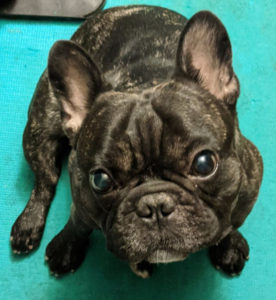In our little morning training session today, Torque reminded Hope that all behaviors should be treated equal.
Most rewarding

All dogs will, pretty reliably, do what’s most rewarding to them. They’re excellent at acting in their own best interests. Whatever got them the most valuable feedback (treats, toys, praise, pets, games) is probably what they’ll do again.
Lately, Hope and Torque have been focusing on his “bow” behavior. Mostly because he’s stuck in a “cone of shame” while his corneal ulcer heals and there are lots of things he can’t do in a cone. Also because it’s fun to teach and learn new “stuff.” And because Torque had started anticipating positions in practice, so it was time to mix it up.
One of Torque and Hope’s favorite behaviors is what the AKC calls the “Command Discrimination,” where the person asks the dog to either Sit, Stand, and Down. In the higher levels, it can be done in any order.
When we practice, we try to mix it up so the dog actually listens, instead of just performing a learned pattern. Dogs love routine and patterns, so if you always do things in the same order, your dog will learn that and do it automatically, rather than actually paying attention. Changing the order teaches the dog to listen and watch, rather than performing a memorized routine.
Difference in a nutshell
And that, in a single sentence, is the difference between old-school dog training and the science-based, positive training we teach. We’re teaching dogs to listen, understand, learn, and act. This way our dogs know what they’re doing, can do it in any order, always have fun doing it, and love playing training games with us.
Hope found herself in a bit of a pickle. With only three commands to discriminate among, Torque had a 50 percent chance of getting the next one right, so he’d gamble and “help” Hope decide on the next call. Which resulted in him getting rewarded about half the time if his timing was spot on. He wasn’t waiting to hear what Hope asked for, he was guessing. And he’s a really good guesser.
Bowing to the inevitable
So Hope introduced the “bow” as another command to choose. It’s not part of the competition, so it’s only for practice, but it’s also really, really cute.
It was only last week that Torque showed he understood what “bow” was – front legs flat on the ground, butt in the air. And Hope rewarded it enthusiastically. Torque and Hope were both smiling and proud of him.
So today, when Hope was playing the Command Discrimination game, Torque started “bowing” every time she opened her mouth to say anything. He was performing the behavior that, most recently, was most rewarded. Which was a perfect reminder to treat all behaviors equally – reward everything you like. Ignore what you don’t.
More of what you want
Fran and her 1-year-old Simon have been working on the “Stand” part, both for the Command Discrimination and the Novice “Stand for Examination.” Same thing – Stand has been heavily rewarded recently, so Simon was choosing it, regardless of what Fran asked for.
Every time we play training games with our dogs they show us what they’ve been learning. Whether or not it’s what we meant to teach them – it’s the information we need to do a better job of communicating with them.






